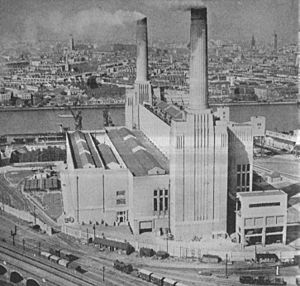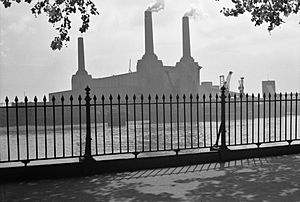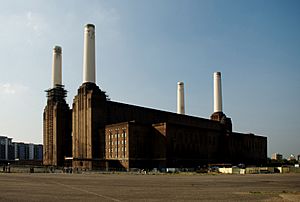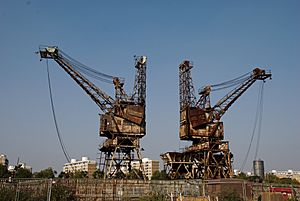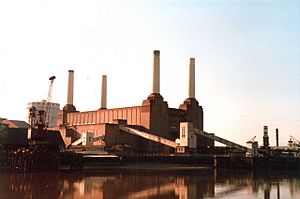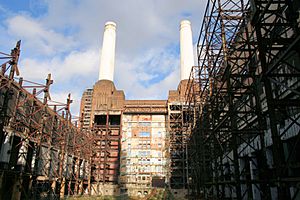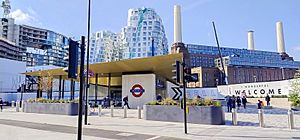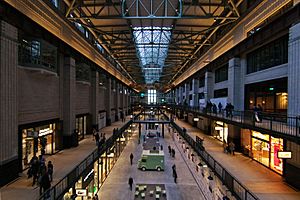Battersea Power Station facts for kids
Quick facts for kids Battersea Power Station |
|
|---|---|
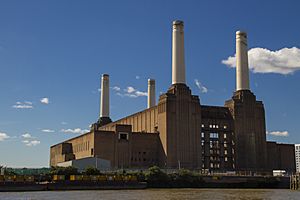
Battersea Power Station
Viewed from the north bank of the Thames in August 2012 |
|
| Country | England |
| Location | Nine Elms, Battersea, Wandsworth, South West London |
| Coordinates | 51°28′54″N 0°8′41″W / 51.48167°N 0.14472°W |
| Status | Decommissioned and in redevelopment |
| Construction began | 1929 (A station) 1945 (B station) |
| Commission date | 1933–35 (A station) 1953–55 (B station) |
| Decommission date | 1975 (A station) 1983 (B station) |
| Construction cost | £2,141,550 (A station) |
| Owner(s) | London Power Company (1939–1948) British Electricity Authority (1948–1955) Central Electricity Authority (1955–1957) Central Electricity Generating Board (1957–1983) |
|
Listed Building – Grade II*
|
|
| Official name: Battersea Power Station | |
| Designated: | 14 October 1980 |
| Reference #: | 1357620 |
Battersea Power Station is a huge, old coal-fired power station in London. It sits on the south bank of the River Thames in an area called Nine Elms, Battersea. It was designed by Leonard Pearce and architects J. Theo Halliday and Giles Gilbert Scott. This building is one of the world's largest made of brick. It is also famous for its cool, original Art Deco style inside.
The building actually holds two power stations. Battersea A Power Station was built first, from 1929 to 1935. Then, Battersea B Power Station was built next to it, starting in 1937. Work stopped during World War II and finished in 1955. Both parts were built to look almost the same. This is why the station has its famous four chimneys.
"Battersea A" stopped working in 1975. In 1980, the whole building was given a special "listed status" to protect it. "Battersea B" closed three years later in 1983. In 2007, its protected status was made even higher. The building was empty for a long time, almost falling apart by 2014. Many ideas were suggested to use the building, but none worked out.
In 2012, a deal was made with Malaysian companies to fix up the site. The plan was to create homes, shops, restaurants, offices (including for Apple), and entertainment areas. The plans were approved, and work began. The main Power Station building finally opened to the public in October 2022.
Today, the building and the whole 42-acre site are owned by a group of Malaysian investors.
Contents
History of Battersea Power Station
This huge building on the south bank of the River Thames in Nine Elms, Battersea, is actually two power stations joined together. Battersea A Power Station was built in the 1930s. Battersea B Power Station, built to its east, was finished in the 1950s. They were designed to look almost identical, which is why the building has its famous four chimneys.
The power station stopped producing electricity between 1975 and 1983. It then stayed empty until 2014. In 1980, it was given a special Grade II listed building status, meaning it was important and needed to be protected. This status was upgraded to Grade II* in 2007.
Battersea Power Station is one of the biggest brick buildings in the world. It's known for its fancy Art Deco style inside. After it closed, the building was unused for over 30 years. In 2008, experts said it was in "very bad" condition. It was even put on a list of endangered monuments.
Many plans were made to fix up the station over the years. In 2004, one project failed. The site was then sold to another company in 2006. They planned to fix the station and build 3,400 homes. But this plan also fell apart because of money problems. The site was put up for sale again in 2011. It was a big challenge to develop the site because of its huge debt and the need to pay for a new London Underground extension.
Why Battersea Power Station Was Built
Before the late 1930s, many small companies supplied electricity. They built power stations for specific industries and sold extra electricity to people nearby. These companies used different power standards. In 1925, the government decided that Britain needed one big, public power system. Several private power companies then formed the London Power Company (LPC). They decided to build a few very large power stations.
The LPC planned its first "super power station" in Battersea, on the south bank of the River Thames. The idea was proposed in 1927. It would be built in two stages and could make 400 megawatts (MW) of electricity. The chosen spot was a 15-acre piece of land that used to be water reservoirs. This spot was perfect because it was close to the River Thames for cooling water and coal delivery. It was also in the middle of London, where the electricity was needed most.
Dealing with Public Concerns
The plan for such a huge building caused protests. People worried it would be too big and ugly. They also feared pollution would harm local buildings, parks, and even paintings in the nearby Tate Gallery. To calm fears about its look, the company hired Sir Giles Gilbert Scott. He was a famous architect who designed the red telephone box and Liverpool Anglican Cathedral. He also designed another London power station, Bankside, which is now the Tate Modern art gallery.
The pollution problem was solved by allowing the station to be built only if its smoke was treated. This made sure the emissions were "clean and smokeless."
Building the Power Station
Construction of the first part, the A Station, began in March 1929. The main building work was done by John Mowlem & Co. The steel frame was put up by Sir William Arrol & Co.. Most of the electrical equipment, like the steam turbines, came from Metropolitan-Vickers in Manchester. The steel frame started going up in October 1930. Then, the brick walls began in March 1931. The A Station started making electricity in 1933 and was fully finished in 1935. It cost about £2.1 million to build.
After World War II, work began on the second part, the B Station. It started operating between 1953 and 1955. It looked almost exactly like the A Station from the outside. It was built right next to it, making the power station have its well-known four chimneys. With the B Station, the site could make 509 MW of power. This made it the third largest power site in the UK at the time. It supplied a fifth of London's electricity. When it opened, it was also the most energy-efficient power station in the world.
The A Station was run by the London Power Company. But by the time the B Station was finished, the UK's electricity supply was controlled by the government. So, the British Electricity Authority owned both stations from 1948.
In 1964, a fire at the power station caused blackouts across London. This even delayed the launch of BBC2 television that night!
Design and Features
A team of architects and engineers designed both parts of the station. Leonard Pearce was the main engineer. Other important engineers included Henry Newmarch Allott and T. P. O'Sullivan. J. Theo Halliday was the architect in charge of how the building looked inside and out. Sir Giles Gilbert Scott joined later to help with the building's outside appearance, especially to please the public.
The station was designed in a "brick-cathedral" style, which was popular then. Battersea is one of the few examples of this style left in the UK. The design was popular right away. It was called a "temple of power" and was seen as important as St Paul's Cathedral as a London landmark. In a 1939 survey, famous people even ranked it as their second favourite modern building.
The A station's control room had many Art Deco features designed by Halliday. It used Italian marble in the turbine hall. Polished wooden floors and wrought-iron staircases were used everywhere. The B Station's inside was not as fancy because there wasn't much money after World War II. Its fittings were made from stainless steel instead.
Each of the two connected stations has a long boiler house with a chimney at each end. Next to it is a turbine hall. The main building is made of a steel frame covered in brick. It's similar to skyscrapers built in the United States around the same time. This station is the largest brick structure in Europe. The building is about 160 meters long and 170 meters wide. The boiler house roof is over 50 meters high. Each of the four concrete chimneys is 103 meters tall. They are 8.5 meters wide at the bottom and 6.7 meters at the top. The station also had places to unload coal, a coal storage area, control rooms, and offices.
The A Station made electricity using three large machines called turbo alternators. The B Station also had three turbo alternators. Together, they made the site's total power capacity 503 MW. All the station's boilers were made by Babcock & Wilcox and used pulverised coal. There were nine boilers in the A station and six in the B station. The B station's boilers were the biggest ever built in the UK at that time. The B station was also the most energy-efficient power station in the country for its first 12 years.
How Battersea Power Station Worked
Coal Delivery
The power station used over 1 million tonnes of coal every year. Most of this coal came from mines in South Wales and North East England. It was brought by special ships called colliers. These ships were designed to be low so they could fit under the Thames' bridges.
Coal was usually unloaded at the jetty by two cranes. These cranes could unload two ships at once, moving 480 tonnes of coal per hour. Some coal also arrived by train from the nearby Brighton Main Line. A system of conveyor belts moved the coal to a storage area or directly to the station's boiler rooms. The storage area was a huge concrete box that could hold 75,000 tonnes of coal.
Water System
Water is very important for a thermal power station. It is used to cool down steam from the turbines before the water goes back to the boiler. The station took water from the River Thames. It could use about 1.5 million cubic meters of water from the river each day.
After World War II, the London Power Company used the station's waste heat to warm homes in Pimlico.
Cleaning the Smoke
Reducing sulphur emissions was a big concern even when the station was being designed. The London Power Company created a new way to wash the smoke in 1925. This process used water and special sprays to clean the gases. It was one of the first times this technique was used on a large scale. However, this process was stopped in the B Station in the 1960s. It was found that putting the waste products into the Thames was actually worse for the environment than letting the sulphur dioxide go into the air.
Electricity Production Over Time
Here's how much electricity Battersea A and B power stations produced each year:
Battersea A annual electricity output GWh.<graph>{ "version": 2, "width": 500, "height": 200, "data": [ { "name": "table", "values": [ { "x": 1964, "y": 515 }, { "x": 1965, "y": 415 }, { "x": 1966, "y": 399 }, { "x": 1967, "y": 378 }, { "x": 1968, "y": 358 }, { "x": 1969, "y": 327 }, { "x": 1970, "y": 325 }, { "x": 1971, "y": 223 }, { "x": 1972, "y": 197 }, { "x": 1973, "y": 155 }, { "x": 1974, "y": 136 }, { "x": 1975, "y": 0 }, { "x": 1961, "y": 428 } ] } ], "scales": [ { "name": "x", "type": "ordinal", "range": "width", "zero": false, "domain": { "data": "table", "field": "x" } }, { "name": "y", "type": "linear", "range": "height", "nice": true, "domain": { "data": "table", "field": "y" } } ], "axes": [ { "type": "x", "scale": "x" }, { "type": "y", "scale": "y" } ], "marks": [ { "type": "rect", "from": { "data": "table" }, "properties": { "enter": { "x": { "scale": "x", "field": "x" }, "y": { "scale": "y", "field": "y" }, "y2": { "scale": "y", "value": 0 }, "fill": { "value": "steelblue" }, "width": { "scale": "x", "band": "true", "offset": -1 } } } } ] }</graph>Battersea B annual electricity output GWh.<graph>{ "version": 2, "width": 750, "height": 250, "data": [ { "name": "table", "values": [ { "x": 1964, "y": 1036 }, { "x": 1965, "y": 1096 }, { "x": 1966, "y": 780 }, { "x": 1967, "y": 845 }, { "x": 1968, "y": 969 }, { "x": 1969, "y": 1061 }, { "x": 1970, "y": 1082 }, { "x": 1971, "y": 1062 }, { "x": 1972, "y": 907 }, { "x": 1973, "y": 670 }, { "x": 1974, "y": 485 }, { "x": 1975, "y": 612 }, { "x": 1976, "y": 511 }, { "x": 1977, "y": 347 }, { "x": 1978, "y": 434 }, { "x": 1979, "y": 193 }, { "x": 1980, "y": 279 }, { "x": 1981, "y": 150 }, { "x": 1982, "y": 97 }, { "x": 1983, "y": 32 }, { "x": 1984, "y": 0 }, { "x": 1961, "y": 830 } ] } ], "scales": [ { "name": "x", "type": "ordinal", "range": "width", "zero": false, "domain": { "data": "table", "field": "x" } }, { "name": "y", "type": "linear", "range": "height", "nice": true, "domain": { "data": "table", "field": "y" } } ], "axes": [ { "type": "x", "scale": "x" }, { "type": "y", "scale": "y" } ], "marks": [ { "type": "rect", "from": { "data": "table" }, "properties": { "enter": { "x": { "scale": "x", "field": "x" }, "y": { "scale": "y", "field": "y" }, "y2": { "scale": "y", "value": 0 }, "fill": { "value": "steelblue" }, "width": { "scale": "x", "band": "true", "offset": -1 } } } } ] }</graph>
Closure and New Life
Why the Power Station Closed
The power station closed because its machines got old and it became too expensive to run. On March 17, 1975, the A Station closed after 40 years. By then, it was also burning oil and making less power.
Three years after the A Station closed, people started to worry that the B Station would close too. A campaign began to save the building. Because of this, the station was declared a heritage site in 1980. This meant it was protected. On October 31, 1983, the B Station also stopped making electricity after almost 30 years. The main reasons for closing both stations were that the equipment was old and that other fuels like oil, gas, and nuclear power became more popular for making electricity.
Early Ideas for Redevelopment
After the station closed, the owners thought about tearing it down. But because it was a protected building, they had to pay a lot to keep it. In 1983, they held a competition for new ideas. A group led by developer David Roche won. They suggested turning it into an indoor theme park with shops and restaurants. This idea was very expensive and needed millions of visitors to make money. Work started in 1987, but it stopped in 1989 because they ran out of money. By then, huge parts of the roof had been removed, leaving the building open to the weather.
In 1990, the plan changed to offices, shops, and a hotel. This was approved, but no more work happened until 1993.
New Owners and New Plans
In 1993, a company from Hong Kong called Parkview International bought the site. They planned a huge £1.1 billion project to fix the building and turn it into a place for shops, homes, and fun.
One big plan, called "The Power Station," was designed by architect Nicholas Grimshaw. It suggested a shopping mall with many restaurants, cafes, bars, and shops. There would also be nightclubs, comedy shows, and a cinema. The old boiler house would be covered with glass and used for public events. A walkway along the river would also be built.
Parkview said the project would create thousands of jobs. But a local group called the Battersea Power Station Community Group was against the plan. They said it didn't have affordable homes or good jobs for local people. They also worried that tall new buildings would hide the power station.
In 2005, there was a debate about the chimneys. Parkview and local authorities said the chimneys were too damaged to repair and needed to be torn down and rebuilt. But other groups said they could be fixed. Parkview promised to rebuild them exactly as they were.
Another Developer's Vision
In 2006, another company, Real Estate Opportunities (REO), bought the site. They hired architect Rafael Viñoly to create a new plan. This plan first included a very tall "eco tower," which London's mayor called an "inverted toilet-roll holder." This tower was quickly removed from the plan.
REO's plans included using part of the station to make power again, using biomass and waste. The old chimneys would be used to let out steam. The turbine halls would become shops, and the roofless boiler house would be a park. There would also be an energy museum. Fixing the power station building alone would cost £150 million.
An "eco-dome" building was also planned. It would have offices and aim to use much less energy. About 3,200 new homes would also be built for 7,000 people.
In 2008, a survey showed that most people liked the plans. In 2010, the local council approved the plans. REO hoped to start building in 2011, but this didn't happen. The station was expected to be fixed by 2016, with the whole project finished by 2020. The plans included 3,400 apartments and huge office spaces. About 28,000 residents and 25,000 workers were expected to be there once it was done.
However, in 2011, REO's plan also failed due to money problems.
Other Ideas and Chelsea F.C. Interest
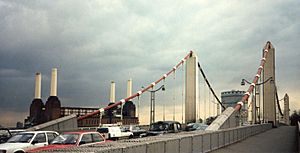
In 2012, architect Sir Terry Farrell suggested turning the site into an "urban park." This plan would have removed most of the building, which was unlikely to happen because of its protected status.
Chelsea F.C. also showed interest in buying the site to build a new football stadium for 60,000 to 75,000 fans. They made a bid in 2012, but it was not accepted.
The Successful Redevelopment (2012 onwards)
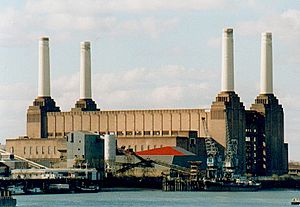
After many failed attempts, the power station was put up for sale again in 2012. Many groups were interested. In June 2012, a deal was made with a group of Malaysian companies. The sale was completed in September 2012.
The new plan uses the existing design ideas. It makes the power station the main focus of the area. It now has shops, cafes, restaurants, art and fun places, offices, and homes. The plan includes fixing the old power station, creating a new park by the river, and building a new main street. This street connects the future Battersea Power Station tube station to the power station. The project also extends the riverside walk and makes it easier to get to Battersea Park. The whole project has eight main stages. It includes over 800 homes.
Work on the first phase, called Circus West Village, started in 2013 and finished in 2017. The Northern Line extension and its new station opened in 2021. Circus West Village now has over 1500 residents and many restaurants, cafes, and shops.
Architects WilkinsonEyre were chosen in 2013 to restore the power station. Work began that year. Plans included fixing the Art Deco style inside and out, rebuilding the chimneys, and fixing the old cranes and jetty for a new river taxi stop. The chimneys were finished in 2017. In 2019, the jetty opened to the public for the first time. Many shops are now open inside the power station. In May 2021, the first residents moved into their new homes there. A 200-seat theatre, the Turbine Theatre, also opened nearby in 2019.
In 2013, famous architects Frank Gehry and Foster + Partners were chosen to design "Phase 3" of the project. This part will be the main entrance to the whole area and the new tube station.
London Underground Extension
The London Underground's Northern line was extended to reach Nine Elms and the power station. It branches off at Kennington station. Two new stations, Nine Elms and Battersea Power Station, opened on September 20, 2021. The extension cost £1.1 billion and is 3 kilometers long. The developers helped pay £270 million towards building it.
Apple's New London Home
In September 2016, Apple announced that it would move 1,400 of its London employees to the power station by 2021. They would take up a huge amount of space inside the building for their new London headquarters. The move was delayed to 2022 because of the COVID-19 pandemic. Apple and other companies will share the site with over 4,000 homes.
Grand Opening in 2022
After almost 40 years since it stopped making electricity, Battersea Power Station opened its doors to the public on Friday, October 14, 2022. This was the first time people could explore the famous building and its new shops, bars, restaurants, and fun places.
Electric Boulevard, a new street for walking, also opened that day. It runs from the new buildings to the riverside and the tube station.
Besides the 254 apartments inside the power station itself, the 42-acre site also has apartment buildings designed by architects Frank Gehry and Foster + Partners. The first residents had already moved into the power station in May 2021.
Battersea Power Station as an Event Venue
The power station has been used for different sports, cultural, and political events. Since 2009, it has hosted the Red Bull X-Fighters event. In 2010, the Conservative Party used the station to launch their election plans. Sky News also used the site for their election coverage. More recently, the power station has been used for a cool light show.
See also
- Energy in the United Kingdom
- Energy policy of the United Kingdom


